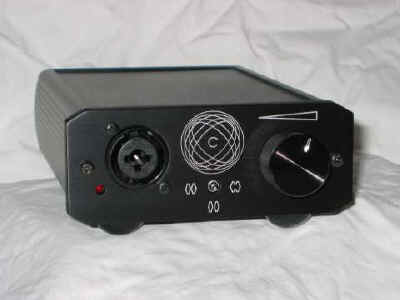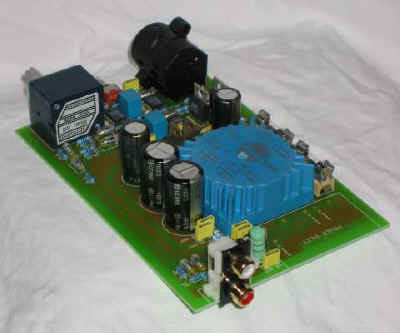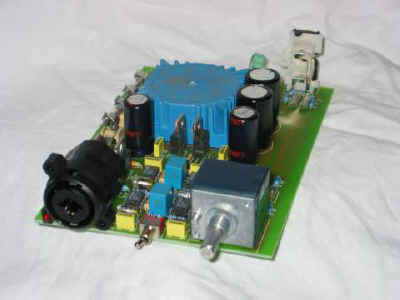You are reading the older HTML site
Positive Feedback ISSUE 9
october/november 2003
meier audio
HA-1 Mark II headphone amplifier
as reviewed by Gary L. Beard and John Brazier

LOUDSPEAKERS ELECTRONICS SOURCES CABLES ACCESSORIES
|
 In my zeal to learn about headphones
prior to making my first purchase, I spent quite a bit of time lurking at Head-fi (www.head-fi.org ), a great web resource dedicated to
all things headphone. One name that kept popping up was that of Dr. Jan Meier. His
company, Meier Audio, is based in
Germany. In addition to selling headphones, he designs and manufactures his own Meier
Audio line of portable and domestic headphone amps. Lately, I have had the pleasure of
reviewing the Mark 2 version of his entry-level home amp, the Corda HA-1.
In my zeal to learn about headphones
prior to making my first purchase, I spent quite a bit of time lurking at Head-fi (www.head-fi.org ), a great web resource dedicated to
all things headphone. One name that kept popping up was that of Dr. Jan Meier. His
company, Meier Audio, is based in
Germany. In addition to selling headphones, he designs and manufactures his own Meier
Audio line of portable and domestic headphone amps. Lately, I have had the pleasure of
reviewing the Mark 2 version of his entry-level home amp, the Corda HA-1.
The Corda is a small, attractive, one-box amp using a solid state, op-amp-based design. The front of its lightweight black case is adorned with an ALPS Blue volume pot, a power LED, and a three-position crossfeed switch (stereo, low, medium). The back has one pair of RCA single-ended inputs, a power switch, and an IEC receptacle for a detachable power cord. There are four soft plastic feet to isolate the unit from vibration and keep it from sliding around. The build quality is very good. The volume control is very stable, and while I did not detect any tracking error, it is not as smooth in operation as more expensive pots. My only real complaint is the position of the RCA jacks—they are very close together and arranged vertically, so if you are using big connectors, beware. I drove the HA-1 directly from my CD player and from my preamp’s tape outputs, and found the sound to be quite engaging with both, though I did prefer the preamp by a slight margin.
The HA-1 is quiet, detailed, and musical. It seems aimed at showing off the warmth of the upper bass/lower midband regions, and does this to great effect. When used with my Sennheiser HD600 headphones and their stock cord, it put me in one of the front few rows. In comparison to the Emmeline HR-2 (at twice the price), I found the Meier amp more exciting and immediate. Nevertheless, it also sounded more two-dimensional than the Emmeline. Even with the crossfeed circuit engaged, the soundstage was somewhat flat, and it didn’t have the Emmeline’s ability to create air and space around the musicians. On the other hand, it sounded clear and smooth, had very good treble extension, and its slightly warm bass was rich and deep. The Meier is highly resolving, but its midrange coloration gives it a definite voice. This is both a strong selling point and one of the most noticeable differences between it and the HR-2.
On Sheffield Labs’ Crème De La Crème CD, the strings on "Blackbird" were warm and vibrant. On "Cripple Creek Breakdown," the drumheads resonated with each strike of the stick, and the electric bass was funky and fun. However, in comparison to the Emmeline, the timbre of the instruments did not seem quite as natural, and the overall sound was just a wee bit too warm and rich for me. The sweeping grandeur of "Amanda" came through loud and clear, but the spaciousness I heard on the Emmeline was not as evident on the Corda. These differences are likely due to "error of omission" choices by the designer. The economical Corda HA-1 does what it does very well, but some listeners will like it and some will not. It also seems that the Meier amp loves the Sennheisers, as they have a similarity of voice that breeds synergy. Perhaps that is why it performed so well compared to the more expensive amp.
The crossfeed circuit is very interesting, and while the Corda is not the only headamp on the block to offer the feature, its crossfeed circuit is Dr. Meier’s own patented design. The idea is to add a bit of right channel to the left channel and a bit of left channel to the right—hence the term "crossfeed." On certain source material, this reduces the "blob in the head" image that many object to in headphone listening. The HA-1 offers two levels of crossfeed—low and medium—which sometimes was easily noticed and other times barely made a difference. It depends on how the source recording was made. For the record, I had the circuit switched off most of the time.
While very good, this amp is not as refined as the Emmeline, yet it held its own in comparison. Due to the differences in presentation of the two, it would not surprise me if some choose the Corda over the Emmeline after a cursory listen, or even after a lengthy audition. While their differences were readily apparent, I felt that the Emmeline clearly bested the Meier only after a long audition. When an A/B comparison was tried under less than scientific circumstances, the differences were not great, yet after extended listening, I felt that the little Corda was no match for the Emmeline’s overall refinement.
Given its price, the HA-1 Mark 2 is something of a bargain. Even though it lacks a bit of audiophile refinement, I believe that the Corda is a very musical amplifier, and it should not be dismissed from an audition list because of its price. It is clear that Dr. Meier and company know how to build great headphone amps. I suspect the Corda’s bigger brothers, the HA-2 and the Prehead, will sound terrific. I thoroughly enjoyed listening to the HA-1 Mark 2. My recommendation? If you are in the market for a really good dedicated headphone amp and don’t want to break open the piggy bank, or perhaps you only listen occasionally and don’t need a "statement" headphone amp, the Meier Audio Corda HA-1 Mark 2 deserves to be on your audition list. There are better amps to be had, but they will cost a great deal more. Gary L. Beard

JOHN BRAZIER'S SYSTEM LOUDSPEAKERS ELECTRONICS SOURCE CABLES
|
 With my schedule, turnaround on a
review tends to be three to four weeks. Unfortunately, it took me much longer to write
this review. Fortunately, the more time I spent with the Meier Corda headphone amp, the
more I liked it. The amp is compact, light, and well built. The only weakness I noted in
the construction is that the volume knob had a bit of play—not a really bad thing
unless you enjoy beating up on your audio gear. Otherwise, the amp sits solidly, and is
resistant to errant cable tugs.
With my schedule, turnaround on a
review tends to be three to four weeks. Unfortunately, it took me much longer to write
this review. Fortunately, the more time I spent with the Meier Corda headphone amp, the
more I liked it. The amp is compact, light, and well built. The only weakness I noted in
the construction is that the volume knob had a bit of play—not a really bad thing
unless you enjoy beating up on your audio gear. Otherwise, the amp sits solidly, and is
resistant to errant cable tugs.
The initial listening phase was not too exciting—the presentation seemed a bit blurred. In retrospect, I sense I had become comfortable with the Ray Samuels amp I had previously reviewed, which had a nicely detailed presentation. Nevertheless, I want to evaluate the Corda on its own merits. Music as interpreted by the Corda eventually became fair and even-handed. No particular frequency range was favored over another. I heard extended highs and decent lows. It didn’t go nearly as deep as most other headphone amps I have heard, but the bass was adequate.
A disc that has been heavily rotated of late is the soundtrack to O Brother, Where Art Thou? The tunes, which are rooted in bluegrass, are played by Union Station of Allison Krauss fame. Lots of picking’ and soulful vocals permeate the tracks. The middle of the vocal range has a pleasant tubey-ness. Bluegrass music has such a unique flavor that I am sure that very few manufacturers use it to voice their equipment, but I was taken by the way the Corda captured the tenderness and soulfulness of the voices. Since my once-yearly pilgrimages to the Russian River Bluegrass Festival began, my grass has been blue. The likes of Bill Monroe, David Bromberg and others share the most accessible area of my CD rack, for those times when only bluegrass can ease the day. I was really pleased by the way the Corda handled not only the vocals, but also the contrast between the sharp notes of mandolins and banjos. Given the lack of deep bass in bluegrass, perhaps the Corda’s inability to go deep made it that much more of a pleasure.
 On a more traditional note, Herbie Hancock’s Gershwins World is one
of my go-to discs for well-recorded jazz. The Corda handled jazz as well as it did most
music. On most tracks, the bass was a bit shallow, but the soundstage was wonderful. The
separation between the artists was vivid, and there was enough space around them to convey
the ambience of the venue. The track Summertime, sung by Joni Mitchell, is moody
and rich in texture, and the Corda was able to capture almost everything I know to be
contained within it. Except for some of the most thinly layered textures, it was all
there. Joni Mitchell sounded embodied, and as moody as ever.
On a more traditional note, Herbie Hancock’s Gershwins World is one
of my go-to discs for well-recorded jazz. The Corda handled jazz as well as it did most
music. On most tracks, the bass was a bit shallow, but the soundstage was wonderful. The
separation between the artists was vivid, and there was enough space around them to convey
the ambience of the venue. The track Summertime, sung by Joni Mitchell, is moody
and rich in texture, and the Corda was able to capture almost everything I know to be
contained within it. Except for some of the most thinly layered textures, it was all
there. Joni Mitchell sounded embodied, and as moody as ever.
For me, no review can be complete without a least a brief analysis of how the component handles Ani Difranco. The disc of choice this time around was Dilate. The track "Amazing Grace" is a funky rendition of the Christian classic, driven by a steady, deep bass track and complemented by a secondary vocal track that contains a reading of the tune. This creates is a "sing-as-I-say" dialogue between the elderly voice reading the psalm and Ani singing it, with a tired, scratchy voice on the one side of the room and Ani on the other. The Corda did an excellent job replicating the ambience and the spirit of the recording. The separation between the two voices was convincingly real, and the Corda maintained the distinctly different voices while maintaining a bass track between them.
Male vocals do just as well, and music in general is well defined and accurate in harmonic texture. My only quibble with the Corda is its lightness in the bass. If you’re a rocker, it may not be the answer for you, but if your taste in music runs the full gamut, and you need a reasonably priced headphone amp, the Corda may be it. It does almost everything right. I recommend that you give it a listen. John T. Brazier
Meier Corda HA-1 Mark II
Retail $410 US
Meier Audio
web address: http://home.t-online.de/home/meier-audio

